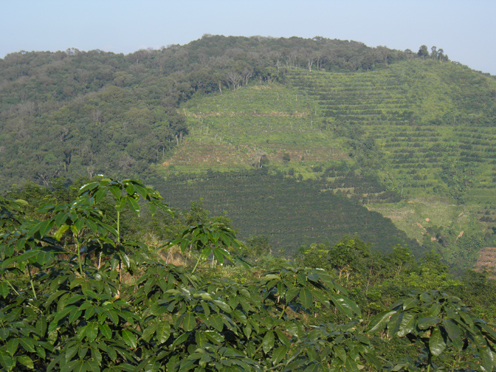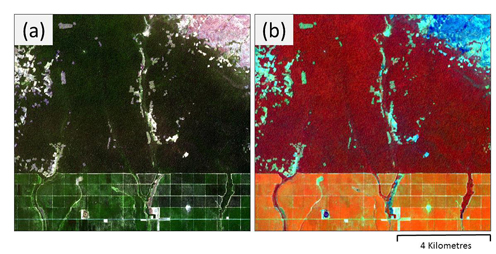Your car tires are clearing the rainforest in Cambodia
Cambodia’s forests are victims of the growing global demand for natural rubber. In just 14 years, just under a quarter of Cambodia’s tropical forests have been cleared to make room for rubber plantations, among other things. The extent of deforestation was found to closely follow the world market price of rubber, according to research from the University of Copenhagen.
From year 2000, the global demand for natural rubber increased dramatically, primarily due to the growth of China’s tyre and automotive industry. Over a fifteen year period from 2001-2015, more than 2.2 million hectares of forest in Cambodia have been felled – equivalent to almost a quarter of the country’s total forest cover, or an area half the size of Denmark. Almost a quarter of this area has been replanted with rubber trees.

From 2001-2015, more than 2.2 million hectares of forest in Cambodia have been felled. Almost a quarter of this area has been replanted with rubber trees. Photo: Patrick Hostert.
It has previously been difficult to document that rising commodity prices of rubber directly accelerate the clearing of the rainforest. But researchers from the Department of Geosciences and Natural Resource Management at the University of Copenhagen have now shown that the fluctuations in global market prices for rubber closely follow the degree of deforestation in Cambodia.
Satellites can see the tropical forest disappear
The researchers have used a combination of satellite images from NASA and the European Space Agency to map the deforestation and calculate the areas that have been converted into rubber plantations. This project was published in the January issue of the journal Nature Plants.
“Most trees look similar in ordinary satellite images. But if you use infrared light, the rubber trees stand out with a distinctive orange colour. In this way, we were able to calculate the prevalence of rubber trees planted at the expense of tropical forest. We could see that when the market price of rubber increased, there was a corresponding increase in deforestation 8-9 months later,” explains Kenneth Grogan, who is a PhD from the University of Copenhagen and lead author of the article.

Figure 1. Rubber plantations appear green in satellite images with standard visible light and thus resemble other tree species (a). By using infrared light, it is easy to differentiate rubber trees from, for example, tropical forest, as they appear with a distinctive orange colour (b). Source: Data from the European Space Agency’s Sentinel-2 satellite.
Deforestation has to a large extent been possible because Cambodia’s government has granted permits – so-called concessions – to large companies, especially from Vietnam and China. A large number of the concessions are located in protected natural areas. While deforestation negatively affects biodiversity and global CO2 balances, the rubber industry has the potential to create income for poor local populations. However, the research indicates that the greatest benefit is accrued instead by the rubber companies.
Demand continues to grow
The researchers’ data highlight the massive challenges that tropical forests are facing in the fight against economically valuable crops such as rubber and palm oil. The demand for rubber – driven by the tyre industry, which consumes 70% of the world’s raw rubber – continues to grow and it is expected that rubber plantations will grow by 4.3–8.5 million hectares over the next decade.
“Cambodia’s forests will continue to dwindle unless the country’s government stops its policy of promoting the development of large commercial plantations in forested areas. Hopefully, our data will be used by various environmental groups as further evidence of the failing international policy regarding tropical forest conservation,” says Kenneth Grogan.
He also hopes that the results can qualify the international debate currently taking place about whether to pay developing countries like Cambodia to stop tropical deforestation.
Cambodia exported 217,500 tons of dry rubber in 2018, an increase of 15 percent from the previous year.
In 2018, the country had a gross income of $287 million from the sale of dry rubber.
A ton of dry rubber cost an average of 1,319 U.S. dollars in 2018.
(Source: https://globalrubbermarkets.com/149134/cambodias-rubber-export-up-15-pct-last-year.html)
Tropical deforestation is expected to account for over 20% of annual global CO2-emissions.
Approximately 70% of the natural rubber produced worldwide is consumed by tyre manufacturers
(source: https://www.michelin.co.uk/tyres/learn-share/tyre-basics/rubber-tree-cultivation)
Read the article in Nature Plants: https://rdcu.be/be1F1
Grogan, K., Pflugmacher, D., Hostert, P., Mertz, O., & Fensholt, R. (2018). Unravelling the link between global rubber price and tropical deforestation in Cambodia. Nature Plants. doi:10.1038/s41477-018-0325-4 https://rdcu.be/be1F1
Contact
Ph.d. Kenneth Grogan
E-mail: kegr@dhigroup.com
Professor Rasmus Fensholt
E-mail: rf@ign.ku.dk
Tel.: 35 32 25 26
Communikations Coordinator
Anette Bill-Jessen
Email: anbj@ign.ku.dk
Tel.: 93 51 13 70
